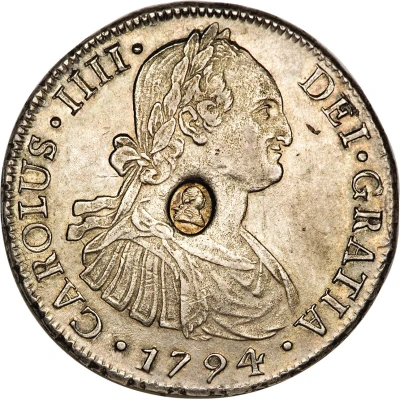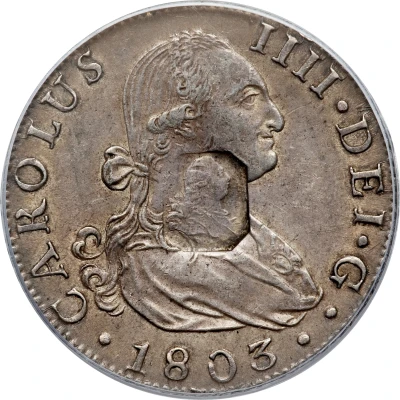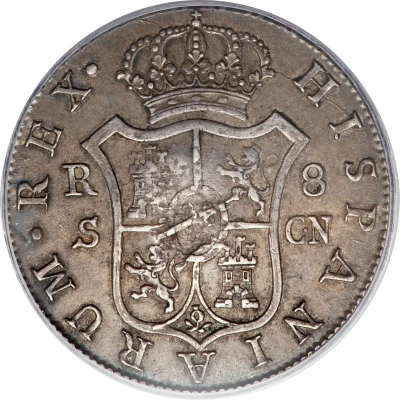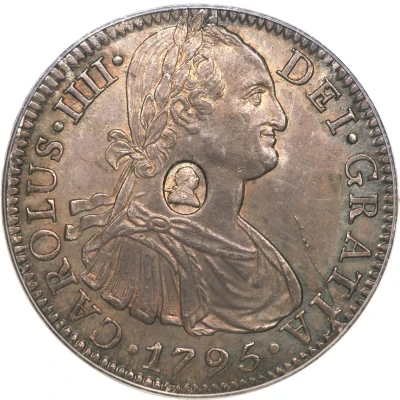
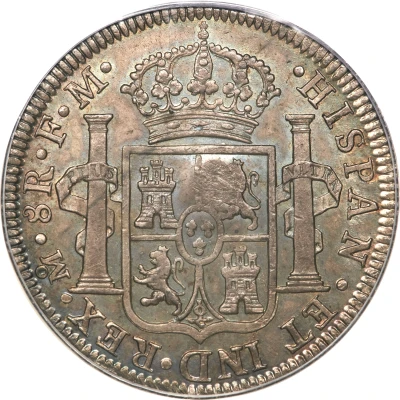

© Heritage Auctions
1 Dollar - George III Type I countermark; oval
| Silver (.896) | 27.1 g | 39 mm |
| Issuer | United Kingdom (United Kingdom, British Overseas Territories and Crown Dependencies) |
|---|---|
| King | George III (1760-1820) |
| Type | Standard circulation coin |
| Years | 1791-1808 |
| Value | 1 Dollar = 4 Shillings 9 Pence (19⁄80) |
| Currency | Countermarked coinage (1797-1804) |
| Composition | Silver (.896) |
| Weight | 27.1 g |
| Diameter | 39 mm |
| Shape | Round |
| Orientation | Medal alignment ↑↑ |
| Demonetized | Yes |
| Updated | 2024-10-09 |
| Numista | N#13155 |
|---|---|
| Rarity index | 84% |
Reverse
Crowned shield of arms dividing pillars, legend around.
Script: Latin
Lettering:
·HISPAN·ET IND·REX· oM · 8R ·F·M·
PLUS VLTRA
Translation: King of Spain and the Indies
Comment
Countermarked Coinage (1797-1804)Emergency issue consisting of foreign silver coins, usually Spanish Colonial, having a bust of George III within an oval (1797) or octagonal (1804) frame. Countermarked 8 Reales circulated at 4 Shillings 9 Pence in 1797 and 5 Shillings in 1804. The puncheons used for countermarking foreign coins for this series were available for many years afterward, especially the oval die and apparently a number of foreign coins other than Spanish or Spanish Colonial 8 Reales were countermarked for collectors.
Issuer: Bank of England; Countermark: Oval, Type I; Date: Dates shown are of the host coin;
Countermarked on Mexico 8 Reales of Carlos IV, KM#109.
For more detail on these emergency issues,
please read THE BANK OF ENGLAND COUNTERMARKED DOLLARS, 1797-1804 by H.E. Manville.
Interesting fact
One interesting fact about the 1791-1808 George III Type I countermark; oval silver dollar coin from the United Kingdom is that it was minted during a time when the country was facing a severe silver shortage. To address this issue, the British government decided to reduce the silver content of the coin from the traditional .925 (sterling silver) to .896, which is still a relatively high percentage of silver. This change in composition helped to conserve silver and ensure the continued production of coins during a time of scarcity. Despite the reduction in silver content, the coin still maintained its value and remained a popular form of currency throughout the British Empire.
Price
| Date | Mintage | VG | F | VF | XF | AU | UNC |
|---|---|---|---|---|---|---|---|
| 1791 FM | - | - | - | - | - | - |
Values in the table are based on evaluations by sales realized on Internet platforms. They serve as an indication only for 1 Dollar - George III (Type I countermark; oval) 1791-1808 coin.
